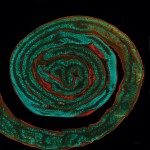Link to Pubmed [PMID] – 18806773
Link to DOI – 10.1038/nature07303
Nature 2008 Oct; 455(7216): 1114-8
The ability to cross host barriers is an essential virulence determinant of invasive microbial pathogens. Listeria monocytogenes is a model microorganism that crosses human intestinal and placental barriers, and causes severe maternofetal infections by an unknown mechanism. Several studies have helped to characterize the bacterial invasion proteins InlA and InlB. However, their respective species specificity has complicated investigations on their in vivo role. Here we describe two novel and complementary animal models for human listeriosis: the gerbil, a natural host for L. monocytogenes, and a knock-in mouse line ubiquitously expressing humanized E-cadherin. Using these two models, we uncover the essential and interdependent roles of InlA and InlB in fetoplacental listeriosis, and thereby decipher the molecular mechanism underlying the ability of a microbe to target and cross the placental barrier.







